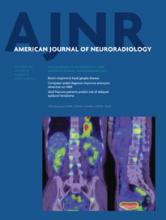Abstract
BACKGROUND AND PURPOSE: Cognitive impairment is a common, disabling symptom of MS. We investigated the association between cognitive impairment and WM dysfunction in secondary-progressive multiple sclerosis using DTI.
MATERIALS AND METHODS: Cognitive performance was assessed with a standard neuropsychological battery, the Minimal Assessment of Cognitive Function in Multiple Sclerosis. Cognitive impairment was defined as scoring >1.5 standard deviations below healthy controls on ≥2 subtests. Fractional anisotropy maps were compared against cognitive status using tract-based spatial statistics with threshold-free cluster enhancement.
RESULTS: Forty-five patients with secondary-progressive multiple sclerosis (median age: 55 years, female/male: 27/18, median Expanded Disability Status Scale Score: 6.5) were prospectively recruited. Cognitively impaired patients (25/45) displayed significantly less normalized global GM and WM volumes (P = .001, P = .024), more normalized T2-weighted and T1-weighted WM lesion volumes (P = .002, P = .006), and lower WM skeleton fractional anisotropy (P < .001) than non-impaired patients. Impaired patients also had significantly lower fractional anisotropy (pcorr < .05) in over 50% of voxels within every major WM tract. The most extensively impinged tracts were the left posterior thalamic radiation (100.0%), corpus callosum (97.8%), and right sagittal stratum (97.5%). No WM voxels had significantly higher fractional anisotropy in patients with cognitive impairment compared with their non-impaired counterparts (pcorr > .05). After the inclusion of confounders in a multivariate logistic regression, only fractional anisotropy remained a significant predictor of cognitive status.
CONCLUSIONS: Cognitively impaired patients with secondary-progressive multiple sclerosis exhibited extensive WM dysfunction, though preferential involvement of WM tracts associated with cognition, such as the corpus callosum, was apparent. Multivariate analysis revealed that only WM skeleton fractional anisotropy was a significant predictor of cognitive status.
ABBREVIATIONS:
- CC
- corpus callosum
- EDSS
- Expanded Disability Status Scale
- FA
- fractional anisotropy
- MNI
- Montreal Neurological Institute
- RRMS
- relapsing-remitting MS
- SPMS
- secondary-progressive MS
- TBSS
- tract-based spatial statistics
- WML
- white matter lesion
- © 2014 by American Journal of Neuroradiology












